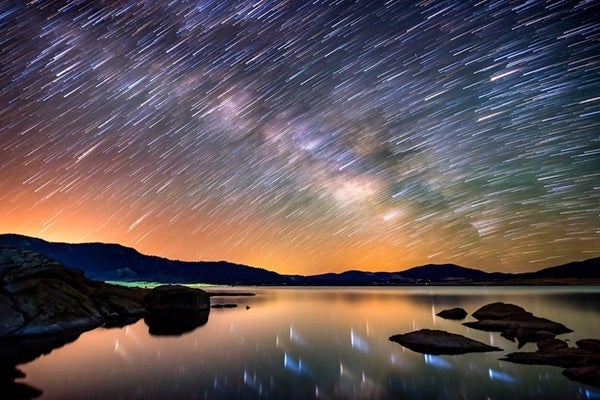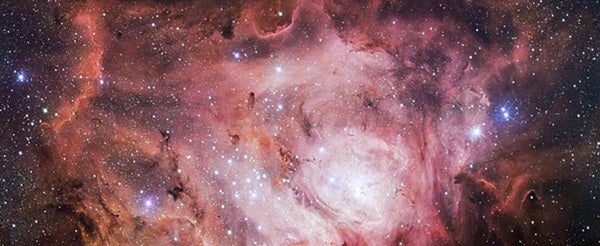Friday, August 24
Mars reached its peak a month ago, but it remains a glorious sight this week. The Red Planet appears low in the southeast as darkness falls and grows more prominent as the evening wears on and it climbs higher. By 11 p.m. local daylight time, it stands about 25° high in the south. The world shines at magnitude –2.3, making it the second-brightest point of light in the night sky after Venus. When viewed through a telescope, the planet’s ocher-colored disk spans 22″. The global dust storm that marred views at opposition continues to wan, providing observers with some nice views of subtle surface features. Mars’ westward motion relative to the background stars carries it across the border from southwestern Capricornus into eastern Sagittarius today. But its stay among the Archer’s stars won’t be lengthy. The planet reaches its stationary point on the 28th and will return to the Sea Goat on September 1.
Saturday, August 25
Full Moon officially arrives at 7:56 a.m. EDT tomorrow morning, but it looks completely illuminated all night. You can find it rising in the east around sunset and then watch it climb high in the south by 1 a.m. local daylight time. It dips low in the west by the time morning twilight starts to paint the sky. The Moon lies against the backdrop of Aquarius the Water-bearer, but its bright glow nearly drowns out the faint stars in this constellation.
Sunday, August 26
Mercury makes an impressive appearance before dawn in late August. It reaches greatest elongation today, when it lies 18° west of the Sun and appears 10° high in the east 30 minutes before sunrise. The innermost planet shines at magnitude –0.2 and is the most conspicuous celestial object near the eastern horizon. A telescope reveals the planet’s disk, which spans 7″ and appears 43 percent lit.
Monday, August 27
Venus dominates the twilight sky after sunset. The dazzling object shines at magnitude –4.6 among the background stars of central Virgo. The planet appears 8° high 45 minutes after sundown and sets shortly after 9 p.m. local daylight time. If you view Venus through binoculars, you’ll see Virgo’s brightest star, 1st-magnitude Spica, 4° to its upper left. (The two objects approach within 1.3° of each other this coming weekend.) A telescope reveals the planet’s disk, which spans 28″ and appears slightly less than half-lit.
Tuesday, August 28
Although Jupiter reached opposition and peak visibility in early May, it remains a conspicuous object from evening twilight until it sets around 10:30 p.m. local daylight time. Jupiter shines at magnitude –1.9 and dominates the southwestern sky after Venus sets. The gas giant resides among the background stars of Libra the Scales; this evening, it lies 1.5° due east of Zubenelgenubi (Alpha [a] Librae). If you view the planet through a telescope, its disk spans 35″ and displays spectacular cloud-top detail.
Wednesday, August 29
The constellations Ursa Major the Great Bear and Cassiopeia the Queen lie on opposite sides of the North Celestial Pole, so they appear to pivot around the North Star (Polaris) throughout the course of the night and the year. In late August and early September, these two constellations appear equally high as darkness falls. You can find Ursa Major and its prominent asterism, the Big Dipper, about 30° above the northwestern horizon. Cassiopeia’s familiar W shape, which currently lies on its side, appears the same height above the northeastern horizon. As the night progresses, Cassiopeia climbs above Polaris while the Big Dipper swings below.
Thursday, August 30
Saturn reached its peak about two months ago, when it appeared opposite the Sun in the sky, but our view of the ringed planet remains magnificent. It appears against the backdrop of northwestern Sagittarius, a region that climbs highest in the south as darkness falls. Saturn continues to shine brightly, too, at magnitude 0.4. Center the planet in your binoculars and you’ll see the Trifid Nebula (M20) 1.7° to the west and the Lagoon Nebula (M8) 2.2° to the southwest. But the best views come through a telescope. Even the smallest instrument shows Saturn’s 17″-diameter disk surrounded by a dramatic ring system that spans 39″ and tilts 27° to our line of sight.
Friday, August 31
Distant Neptune reaches opposition and peak visibility a week from tonight, but the view now is essentially the same. The ice giant planet rises during evening twilight and climbs halfway to the zenith in the southern sky by 1:30 a.m. local daylight time. The magnitude 7.8 planet lies in Aquarius, 2.1° west-southwest of 4th-magnitude Phi (f) Aquarii. You’ll need binoculars to spy Neptune and a telescope to see its blue-gray disk, which spans 2.4″.
Saturday, September 1
The variable star Algol in Perseus reaches minimum brightness at 4:52 a.m. EDT tomorrow morning. If you start watching this evening (it rises in the northeast shortly after 8 p.m. local daylight time), you can see its brightness diminish by 70 percent over the course of about five hours as its magnitude drops from 2.1 to 3.4. This eclipsing binary star runs through a cycle from minimum to maximum and back every 2.87 days.
Mars’ brief excursion into Sagittarius comes to an end today, as it moves eastward across the border into Capricornus.
Sunday, September 2
Last Quarter Moon occurs at 10:37 p.m. EDT. It rises around midnight local daylight time and climbs high in the southeast by the time twilight starts to paint the sky. Earth’s only natural satellite lies just east of the Hyades star cluster and 1st-magnitude Aldebaran in the constellation Taurus the Bull.












